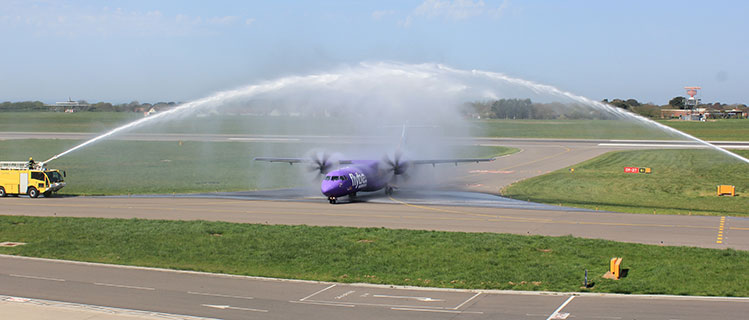Nick Preston talks to Montserrat Barriga, who was appointed as the new Director General of the European Regions Airline Association in late 2017.

Montserrat Barriga, Director General, European Regions Airline Association: “Limited slot capacity means airports need to maximise aircraft size for each slot used, as this maximises both aeronautical and non-aeronautical revenue. This has the effect of making smaller aircraft more expensive on a per-passenger basis. This does create opportunities for regional airports, which have capacity and are therefore looking to attract ‘spill’ traffic from the larger airports.”
On 1 November 2017 Montserrat Barriga officially took up office as Director General of the European Regions Airline Association (ERA). Barriga took time out from her busy schedule to discuss her ambitions for the association and her thoughts on the prospects for regional aviation in Europe.
“Traditionally, a regional airline was defined by the type of aircraft, the business model or the geography,” explains Barriga. “We have evolved that model as many of the old regional airlines have wider types of operations and operate a different range of aircraft sizes. Any European airline primarily operating in Europe can be a potential member of the ERA.”
The latest organisations to join the ERA are Gates Aviation and Chorus Aviation Capital, neither of which are airlines. This highlights the association’s broad variety of members. “The ERA’s members include 50 airlines and 146 other companies, covering the entire spectrum of the aviation industry, including 21 airports, manufacturers, Maintenance Repair and Overhaul (MRO) and service providers,” explains Barriga. “It is important that our members share common interests. Some consider themselves regional and some don’t, but what matters is that their association unites their voices and combines efforts for the sake of the European aviation industry.
“The ERA’s main objectives are to represent member’s interests and priorities with Europe’s main regulatory bodies, protecting them from changing regulatory environments, while also raising the profile of the association and its members by promoting the contribution of our sector to the overall development of Europe. We also provide exclusive business-to-business networking opportunities for members by being a platform for exchanging experience, best practices and support within the ERA network.”
Barriga believes her previous position as Director, International Development & Industry Affairs at Binter Canarias provides her with the perfect insight for understanding the needs of ERA members. “Binter gave me the experience to understand the strategic priorities and challenges for a European operator of average size, expanding internationally, opening new routes in new markets, and gaining and operating Public Service Obligation (PSO) routes, while competing locally, operating in a complex geography, etc. This experience will help me to better serve our airline members, as I can put myself into the operator’s shoes in terms of their operational, commercial and regulatory needs.
“I am very lucky to have come into a strong, well-established trade association,” continues Barriga. “I would like to take the ERA to the next level by retaining and increasing membership and by continuously improving our service to the members.”
Challenges and opportunities lie ahead
Looking to the future, Barriga identifies several challenges facing ERA members, but is certain that regional aviation will continue to play a key role in Europe. “Brexit is one of the biggest challenges for European airlines and our goal is to ensure UK and non-UK members get the support they need from their association throughout the process, and that after its full implementation, they become even stronger,” says Barriga. “Other relevant issues to consider in the future include passenger rights, in particular the development of EU261, slot regulations, and pilot and maintenance engineer shortages.”

ERA member Blue Islands provides links between Guernsey and Jersey, and from those islands to the UK, under a franchise arrangement with Flybe. It recently began operating a series of seasonal Saturday charters from Rotterdam and Zurich to the two largest Channel Islands.
Among the potential challenges, Barriga sees opportunities for ERA members. “Limited slot capacity means airports need to maximise aircraft size for each slot used, as this maximises both aeronautical and non-aeronautical revenue. This has the effect of making smaller aircraft more expensive on a per-passenger basis. This does create opportunities for regional airports, which have capacity and are therefore looking to attract ‘spill’ traffic from the larger airports.”
Barriga believes PSO routes will continue to be a key part of the European regional aviation sector. “PSOs have always been an important tool for developing connectivity in Europe, while limiting the commercial and financial risk for the smaller operators. Many ERA members operate under PSO routes as part of a much wider network. The PSO routes can then benefit from the operator’s larger fleet and scale of operations and be more efficient overall, costing less public funds. We support PSOs as a way to continue developing underserved regions, bringing economic benefits to them in an effective manner.”
Regional aviation could also stand to benefit from an increase in demand for offbeat tourism. “Social media is a key tool and travel bloggers are definitely prescribers to this, especially among younger generations that seek value for money and see flying as the most efficient way of transport,” says Barriga. “Regional operators can provide access to secondary cities and secluded places in Europe, such as islands and remote regions, most of which are very attractive for tourists looking for new destinations.”
In the longer-term, Barriga argues regional airline services will remain in demand due to the complementary connectivity options they offer alongside other business models. “Consumers want two main things: choice and value for money. The airline industry is no different from any other in this regard. Passengers travelling within Europe want to be able to access the best point-to-point connectivity, this means maximising the network of European secondary airports. Regional carriers provide such services. Additionally, regional airlines are seen by passengers and authorities as an important brand for the regions they represent, since they have been providing quality service for many years. Regional carriers are complementary to low-cost and legacy airlines, and are needed to maintain the level of connectivity in Europe and its near regions.”







